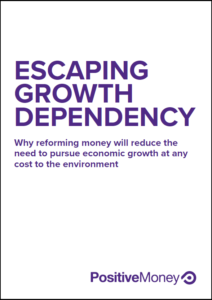
Escaping Growth Dependency
This report from Positive Money is a clear exposition of the factors which drive governments to pursue economic growth despite this being ecologically unsustainable. The focus is on how current system creates high levels of debt, which are only manageable if there is economic growth

Published by Positive Money, 2018
This report from Positive Money is a very clear exposition of the factors which drive governments to pursue economic growth despite this being ecologically unsustainable. Positive Money is an organisation that campaigns for reform of the monetary system: they think we should take away the power of private banks to create money through making loans, and instead bring in a system of sovereign money creation in which the government creates money and spends it into the economy. Therefore there is only a brief analysis of some ‘sources of growth dependency’, such as the need to maintain employment and living standards in the face of population growth, increasing life expectancy and productivity of labour; and the need to reduce poverty without having to make the rich poorer. The focus is on how the current monetary system creates high levels of public and private debt, which are only manageable if there is economic growth.
Chapter 3 of the report is a detailed explanation of how and why private banks create money. This money overwhelmingly goes to finance the purchase of pre-existing assets, especially property (and hence inflates the price of housing relative to earnings - see our report on the housing crisis here.) In good times banks have confidence that loans will be repaid and lend freely, expanding the supply of money, leading to a booming economy. However, as debts rise relative to incomes, the level of defaults increases, leading to a loss of confidence, or borrowers focus on paying down their debt, contracting the money supply and thus demand in the economy. High levels of private debt therefore lead to financial crisis, or at least to recession. These in turn lead to high levels of public debt, as government has to borrow to rescue banks, and recessions cause tax income to fall and expenditure to rise.
The report’s authors argue (in Chapter 4) that reducing high levels of public and private debt requires sustained real growth of the economy. Growth does not of course reduce the nominal value of the debt, just the debt relative to the size of the economy, but this is what matters when it comes to how affordable that debt is. Inflation without growth is insufficient. The conclusion is that high debt, in the current monetary system, is incompatible with a zero-growth or steady-state economy. Positive Money’s answer is to change the monetary system so that money is created without at the same time creating debt.
Positive Money’s proposals for a sovereign money system involve the Treasury issuing non-interest paying bonds which are purchased by the Bank of England using money created for that purpose. These payments would be credited to the government’s account, to be spent into the economy. This debt-free money could reduce the amount of private and public debt, leading to a more stable economy.
Whether this is the right solution is another matter. Ann Pettifor has argued that it would amount to technocrats having control over the money supply, and as those technocrats would, most likely, be mainstream economists, she has little faith that they would get it right (see our review of Ann Pettifor’s 2017 book, The Production of Money). Taking a long view, David Graeber (Graeber, 2014), sees cycles in history alternating between periods in which economies have worked on credit, and those where coinage has dominated. Capitalism, from 1450, has on the whole been a period of coinage: everyday transactions came to be carried out using coins rather than the credit arrangements that dominated the middle ages. But since 1971, when President Nixon announced that foreign-held dollars could no longer be exchanged for gold, money has been purely a matter of credit and debt. In previous times of credit money there were mechanisms in place to protect debtors.
In ancient Mesopotamia there were periodic debt amnesties, where non-commercial debts would be forgiven. In the middle ages strict rules on usury limited the rates of interest that could be charged. Now, however, all the effort of the international community has gone into protecting the creditors. Graeber sees us as at the start of a new period with regard to money and debt, one which we are barely beginning to understand. This lacking of understanding means that money and the banking system appears to be a matter of ‘arcane magic’ (Graeber, 2014, p.371). In 2011 the New Economics Foundation (NEF) published a guide to the UK monetary and banking system which repeatedly points out that the explanations in economic textbooks do not correspond to how banking and money creation actually work.
Both Graeber and NEF argue that money does not arise naturally from the workings of the market, but is brought into being by governments through their requirement that it be used to pay taxes.
It is “a social relation of credit and debt between the state and its citizens” (Ryan-Collins et al, p.116).
It is not a commodity but a social and political construct.
It could therefore be constructed differently: we could, following the middle ages, bring in restrictions on the amount of interest that can be charged; we could control the amount of credit that can be created for particular activities, thus directing money into the parts of the economy that are needed for the transition to a zero-carbon future; we could prevent its creation for speculation and the purchase of assets such as property; we could bring in controls over international capital flows.
Money is critical to modern life and there clearly needs to be reform if we are going to get to a position where debt is not one of the factors driving governments to pursue economic growth at the expense of the environment and people.
Graeber, D. (2014) Debt, the first 5,000 years, London, Melville House Publishing.
Ryan-Collins, J., Greenham, T., Werner R, and Jackson A, (2011), Where does money come from? A Guide to the UK monetary and banking system, London, New Economics Foundation.



